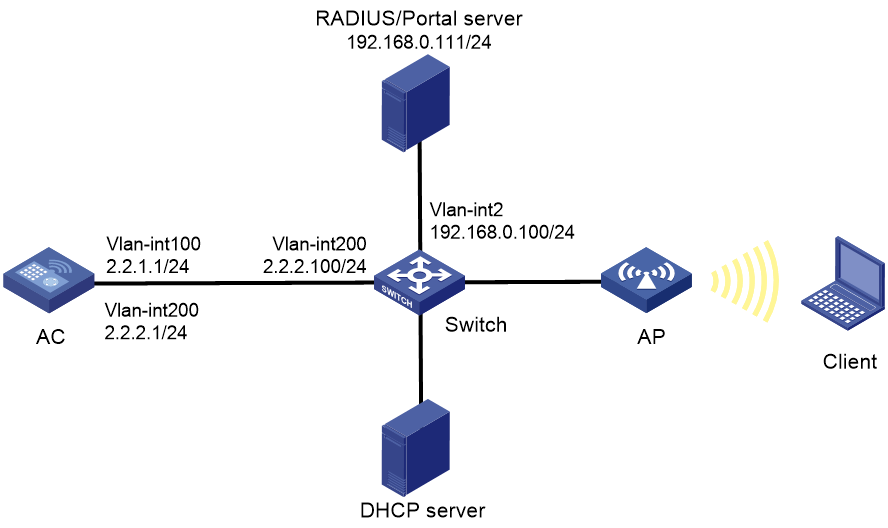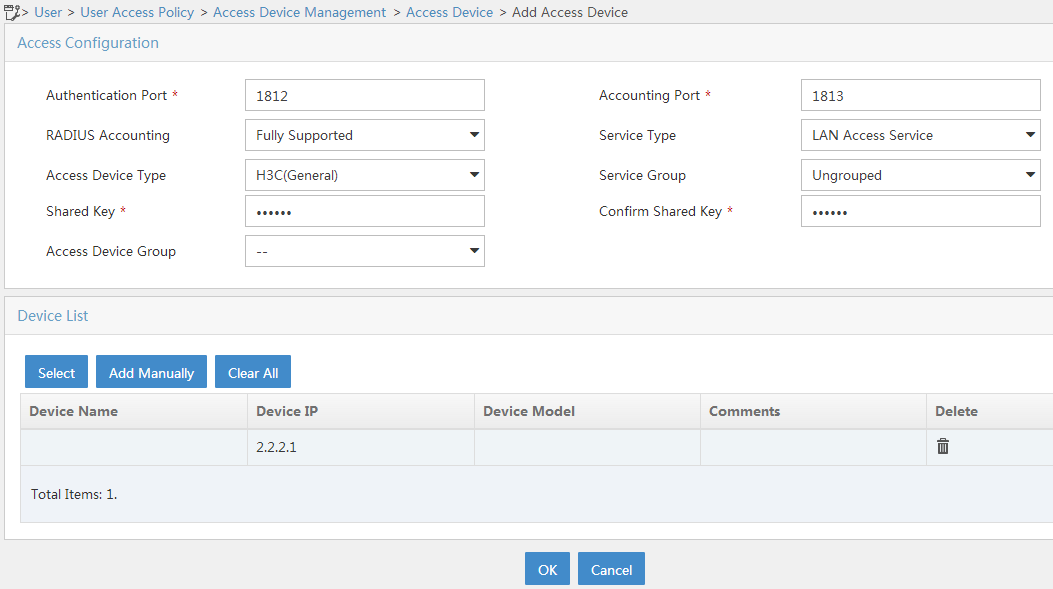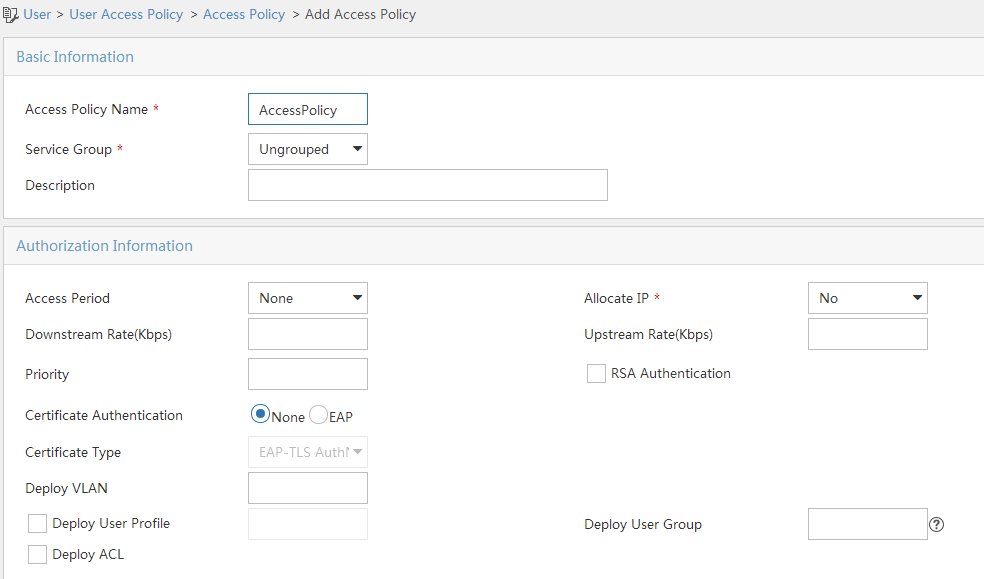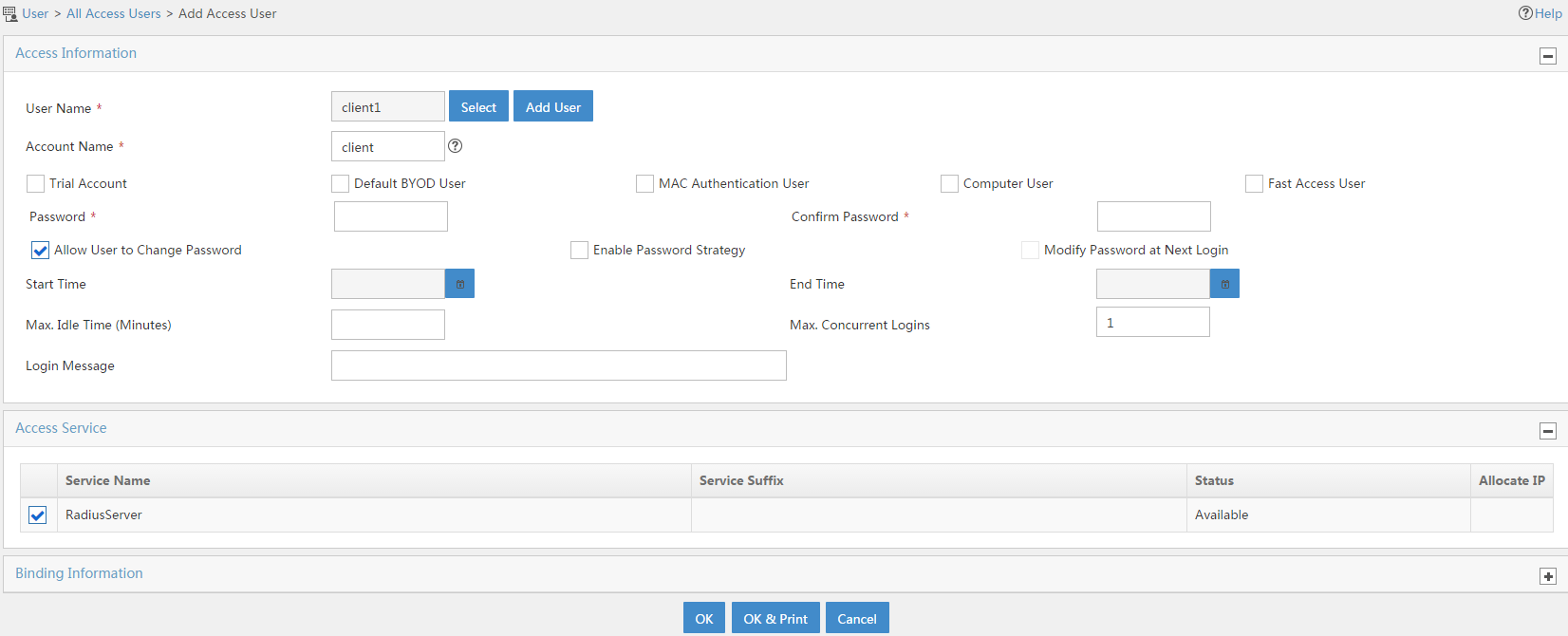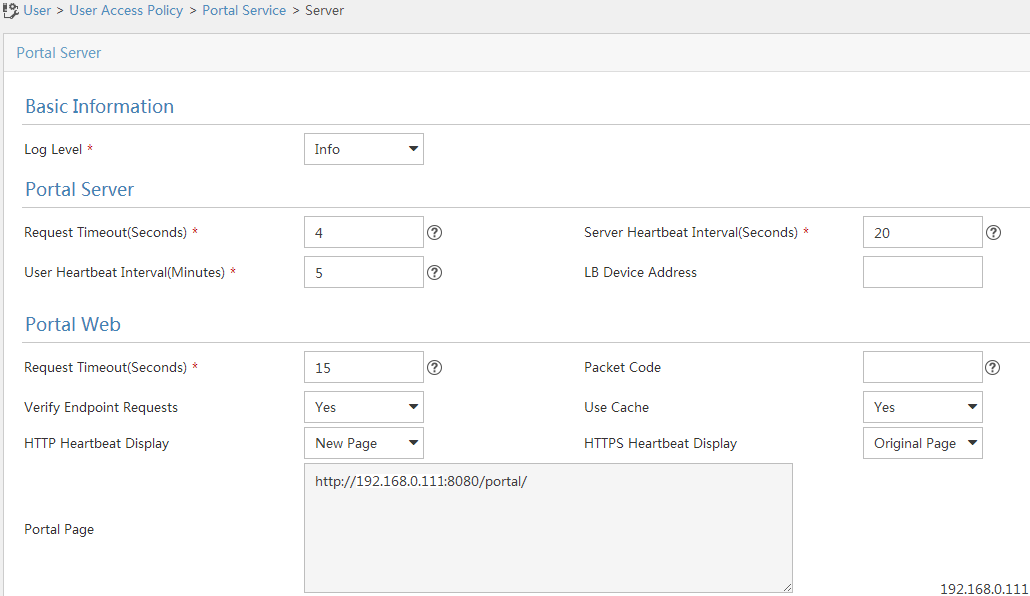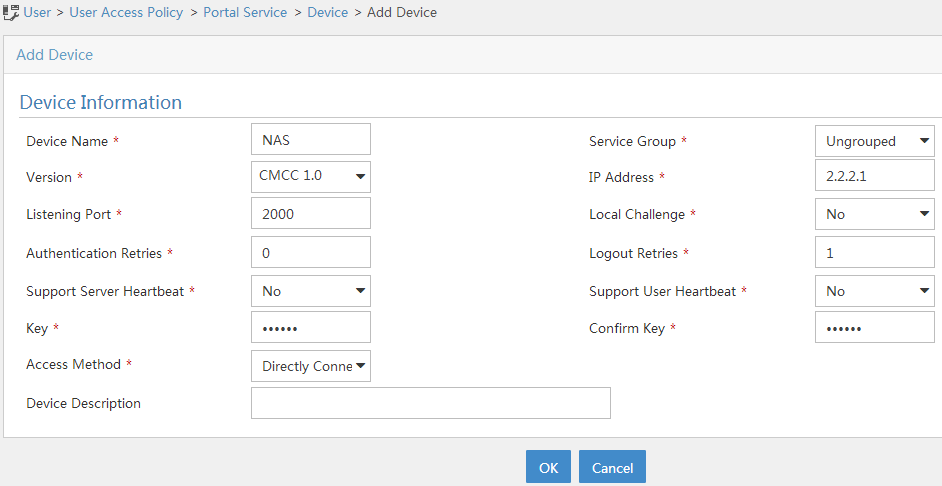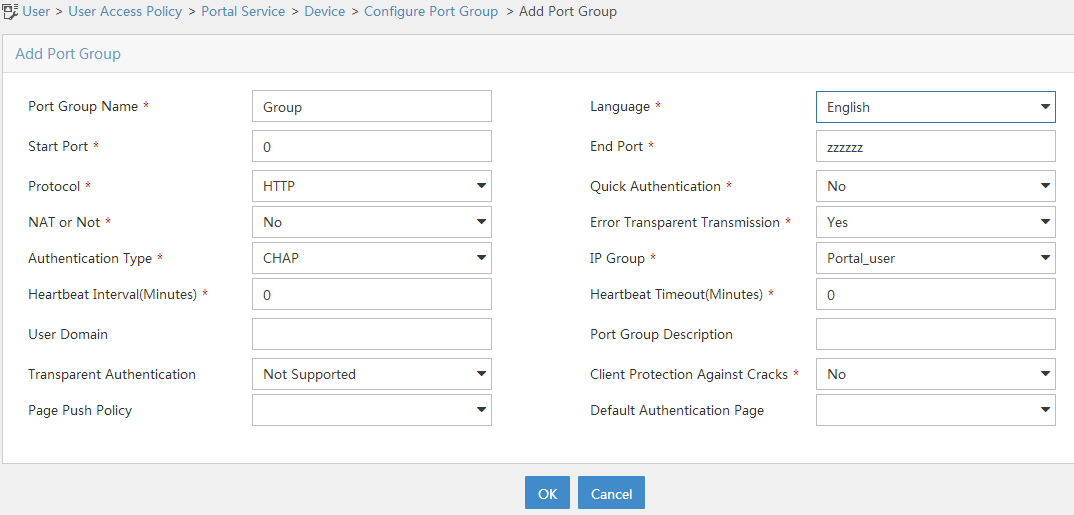- Table of Contents
-
- 03-CLI configuration examples (AC+fit AP)
- 01-HTTPS Login Configuration Examples
- 02-SSH Configuration Examples
- 03-License Management Configuration Examples
- 04-IPv6 URL Redirection Configuration Examples
- 05-AP Association with the AC at Layer 2 Configuration Examples
- 06-AP Association with the AC at Layer 2 (IPv6) Configuration Examples
- 07-Auto AP Configuration Examples
- 08-AP Association with the AC at Layer 3 Configuration Examples
- 09-AP Association with the AC at Layer 3 (IPv6) Configuration Examples
- 10-WEP Encryption Configuration Examples
- 11-PSK Encryption Configuration Examples
- 12-WPA3-SAE PSK Encryption Configuration Examples
- 13-WLAN Access (IPv6) Configuration Examples
- 14-Policy-Based Forwarding with Dual Gateways Configuration Examples
- 15-Scheduled Configuration Deployment by AP Group Configuration Examples
- 16-Inter-AC Roaming with Static Client VLAN Allocation Configuration Examples
- 17-Service Template and Radio Binding Configuration Examples
- 18-Scheduled WLAN Access Services Configuration Examples
- 19-Local Portal Authentication Configuration Examples
- 20-HTTPS-Based Local Portal Authentication Configuration Examples
- 21-Remote Portal Authentication Configuration Examples
- 22-Local Portal Authentication through LDAP Server Configuration Examples
- 23-Local Portal Authentication and SSID-based Authentication Page Pushing Configuration Examples
- 24-Local Portal MAC-Trigger Authentication Configuration Examples
- 25-Portal MAC-Trigger Authentication Configuration Examples
- 26-Local Forwarding Mode and Local Portal MAC-Trigger Authentication Configuration Examples
- 27-Local Portal Authentication (IPv6) Configuration Examples
- 28-Local Portal Authentication through LDAP Server (IPv6) Configuration Examples
- 29-Remote Portal Authentication (IPv6) Configuration Examples
- 30-Portal MAC-Trigger Authentication (IPv6) Configuration Example
- 31-Remote Portal Authentication with User Profile Authorization Configuration Examples
- 32-Portal Fail-Permit Configuration Examples
- 33-Local MAC Authentication Configuration Examples
- 34-MAC Authentication and PSK Authentication Configuration Examples
- 35-Remote MAC and Portal Authentication and Transparent Authentication Configuration Examples
- 36-Remote AP and Remote Portal MAC-Trigger Authentication Configuration Examples
- 37-MAC Authentication with Guest VLAN Assignment Configuration Examples
- 38-MAC Authentication with Guest VLAN Assignment (IPv6) Configuration Examples
- 39-Local MAC-Then-802.1X Authentication Configuration Examples
- 40-Local 802.1X Authentication Configuration Examples
- 41-Local RADIUS-Based 802.1X Authentication in EAP Relay Mode Configuration Examples
- 42-Remote 802.1X Authentication Configuration Examples
- 43-Remote 802.1X Authentication (IPv6) Configuration Examples
- 44-Remote 802.1X Authentication in WPA3-Enterprise Mode Configuration Examples
- 45-802.1X Authentication with ACL Assignment Through IMC Server Configuration Examples
- 46-802.1X Authentication with User Profile Assignment Through IMC Server Configuration Examples
- 47-EAD Authentication Configuration Examples
- 48-EAD Authentication (IPv6) Configuration Examples
- 49-Local Forwarding Mode and Local Portal Authentication Configuration Examples
- 50-Local Forwarding Mode Direct Portal Authentication Configuration Examples
- 51-Local Forwarding Mode Direct Portal Authentication (IPv6) Configuration Examples
- 52-Local Forwarding Configuration Examples
- 53-Remote AP Configuration Examples
- 54-WIPS Configuration Examples
- 55-WIPS Countermeasures Against All SSIDs Configuration Examples
- 56-IP Source Guard (IPv4) Configuration Examples
- 57-IP Source Guard (IPv6) Configuration Examples
- 58-IRF Setup with Members Directly Connected Configuration Examples
- 59-IRF Setup with Members Not Directly Connected Configuration Examples
- 60-IRF Setup with Members in One Chassis Configuration Examples
- 61-IRF Setup with Members in Different Chassis Configuration Examples
- 62-Dual-Link Backup Configuration Examples
- 63-Remote 802.1X Auth on AC Hierarchy Network with Dual-Link Central AC Backup Configuration Examples
- 64-Remote Portal Auth on AC Hierarchy Network with Dual-Link Central AC Backup Configuration Examples
- 65-OAuth-Based Portal MAC-Trigger Auth on Local-Forwarding Dual-Link Backup Configuration Examples
- 66-Dual-Link Backup OAuth-Based Portal Auth in Local Forwarding Configuration Examples
- 67-Dual-Link Backup Remote Portal MAC-Trigger Auth in Local Forwarding Configuration Examples
- 68-Dual-Link Backup Remote Portal and Transparent MAC Auth in Local Forwarding Configuration Examples
- 69-Dual-Link Backup Remote Portal Auth in Local Forwarding Configuration Examples
- 70-Dual-Link Backup Remote Portal and MAC Auth in Centralized Forward Configuration Examples
- 71-Dual-Link Backup Remote Portal Auth in Centralized Forwarding Configuration Examples
- 72-Dual-Link Backup Lightweight Portal Auth in Centralized Forwarding Configuration Examples
- 73-Dual-Link Backup OAuth-Based Portal Auth in Centralized Forwarding Configuration Examples
- 74-Dual-Link Backup Remote Portal MAC-Trigger Auth in Centralized Forwarding Configuration Examples
- 75-Remote 802.1X Auth on a Dual-Link AC Backup Network Configuration Examples
- 76-Remote MAC Auth on a Dual-Link AC Backup Network Configuration Examples
- 77-Remote 802.1X Authentication on an AC Hierarchy Network Configuration Examples
- 78-Remote 802.1X Authentication Configuration Examples
- 79-WLAN Probe Configuration Examples
- 80-Multicast Optimization Configuration Examples
- 81-Client Rate Limiting Configuration Examples
- 82-Inter-AC Roaming Configuration Examples
- 83-Inter-AC Roaming (IPv6) Configuration Examples
- 84-WLAN Load Balancing Configuration Examples
- 85-Static Blacklist Configuration Examples
- 86-Client Quantity Control Configuration Examples
- 87-AP License Synchronization Configuration Examples
- 88-iBeacon Management Configuration Examples
- 89-Mesh Link Establishment Between a Fit AP and a Fat AP Configuration Examples
- 90-Mesh Link Establishment Between Fit APs Configuration Examples
- 91-Auto-DFS and Auto-TPC Configuration Examples
- 92-AP Image Downloading Configuration Examples
- 93-Dual-Uplink Interfaces Configuration Guide
- 94-Internal-to-External Access Through NAT Configuration Examples
- 95-Layer 2 Static Aggregation Configuration Examples
- 96-Layer 2 Multicast Configuration Examples
- 97-Static VLAN Allocation Configuration Examples
- 98-URL Redirection Configuration Examples
- Related Documents
-
| Title | Size | Download |
|---|---|---|
| 50-Local Forwarding Mode Direct Portal Authentication Configuration Examples | 371.80 KB |
|
|
|
H3C Access Controllers |
|
Comware 7 Local Forwarding Mode Direct Portal Authentication |
|
Configuration Examples |
|
|
Copyright © 2022 New H3C Technologies Co., Ltd. All rights reserved.
No part of this manual may be reproduced or transmitted in any form or by any means without prior written consent of New H3C Technologies Co., Ltd.
Except for the trademarks of New H3C Technologies Co., Ltd., any trademarks that may be mentioned in this document are the property of their respective owners.
The information in this document is subject to change without notice.
Contents
Example: Configuring local forwarding mode direct portal authentication
Editing the AP configuration file
Introduction
The following information provides an example of configuring direct portal authentication in a wireless network where APs directly forward client traffic.
Prerequisites
The following information applies to Comware 7-based access controllers and access points. Procedures and information in the examples might be slightly different depending on the software or hardware version of the access controllers and access points.
The configuration examples were created and verified in a lab environment, and all the devices were started with the factory default configuration. When you are working on a live network, make sure you understand the potential impact of every command on your network.
The following information is provided based on the assumption that you have basic knowledge of AAA, portal, and WLAN.
Example: Configuring local forwarding mode direct portal authentication
Network configuration
As shown in Figure 1:
· The AP and the client obtain IP addresses from the DHCP server.
· The AP and the AC use VLAN 100 to establish CAPWAP tunnels, and the client uses VLAN 200 to access the wireless network.
· The AP directly forwards traffic of the client.
· The IMC server acts as the portal authentication server, portal Web server, and RADIUS server.
· The AC performs direct portal authentication on clients. Before passing portal authentication, the client can access only the portal Web server. After passing portal authentication, the client can access other network resources.
· The client user can access network resources on any Layer 2 ports in its access VLAN without re-authentication.
· The IMC server can dynamically change authorization information for the user and can log out the user.
Analysis
To allow an authenticated user to access network resources on any Layer 2 ports in its access VLAN without re-authentication, enable the portal roaming feature.
In wireless networks where the AP forwards client traffic, the AC does not have ARP entries for clients. Therefore, the AC cannot check the validity of portal clients by using ARP entries. To ensure that valid users can perform portal authentication, you must enable wireless client validity check on the AC.
To allow the RADIUS server to modify user authorization information and log out users, enable the RADIUS session-control feature.
To add GigabitEthernet 1/0/1 of the AP to the local forwarding VLAN (VLAN 200), edit the AP's configuration file and upload it to the AC's storage medium.
Restrictions and guidelines
Use the serial ID labeled on the AP's rear panel to specify an AP.
The portal authentication server type and portal Web server type configured on the AC must be the same as the types of the servers actually used. In this example, the server type is CMCC.
By default, the portal Web server URL redirected to users does not carry parameters. You can configure the parameters to be carried in the redirection URL as needed.
Procedures
Configuring IMC
In this example, the IMC server runs IMC PLAT 7.1 (E0303p13), IMC EIA 7.1 (F0302p08), and IMC EIP 7.1 (F0302p08).
Configuring the RADIUS server
1. Add an access device:
a. Log in to IMC and click the User tab.
b. From the navigation tree, select User Access Policy > Access Device Management > Access Device.
c. Click Add to open the Add Access Device page.
d. Configure the shared key as radius.
The shared key must be the same as that configured for the RADIUS server on the AC.
e. In the Device List area, click Add Manually to open the Add Access Device Manually page. Enter the start IP address 2.2.2.1 and click OK.
f. Use the default settings for other parameters.
g. Click OK.
Figure 2 Adding an access device
2. Add an access policy:
a. From the navigation tree, select User Access Policy > Access Policy.
b. Click Add to open the Add Access Policy page.
c. Enter the policy name.
d. Select the service group.
This example uses the default service group (Ungrouped).
e. Use the default settings for other parameters.
f. Click OK.
Figure 3 Adding an access policy
3. Add an access service:
a. From the navigation tree, select User Access Policy > Access Service.
b. Click Add to open the Add Access Service page.
c. Enter the service name.
d. Select the access policy configured in the previous step as the default access policy.
e. Use the default settings for other parameters.
f. Click OK.
Figure 4 Adding an access service
4. Add an access user:
a. From the navigation tree, select Access User > All Access Users.
b. Click Add to open the Add Access User page.
c. Set the user. If the user exists, click Select to select the existing user. If the user does not exist, click Add User to add a new user.
d. Enter the account name.
e. Enter and confirm the password.
f. In the Access Service area, select the access service configured in the previous step.
g. Use the default settings for other parameters.
h. Click OK.
Figure 5 Adding an access user
Configuring the portal server
1. Configure the portal authentication service:
a. Log in to IMC and click the User tab.
b. From the navigation tree, select User Access Policy > Portal Service > Server.
c. Configure the portal server parameters.
This example uses the default settings.
d. Click OK.
Figure 6 Configuring the portal server
2. Configure an IP address group:
a. From the navigation tree, select User Access Policy > Portal Service > IP Group to open the portal IP address group configuration page.
b. Click Add to open the Add IP Group page.
c. Enter the IP group name.
d. Enter the start IP address and end IP address of the IP group.
Make sure the client IP address is in the IP group.
e. Select a service group.
This example uses the default group Ungrouped.
f. Select Normal from the Action list.
g. Click OK.
Figure 7 Adding an IP group
3. Add a portal device:
a. From the navigation tree, select User Access Policy > Portal Service > Device.
b. Click Add to open the Add Device page.
c. Enter the device name NAS.
d. Select CMCC 1.0 from the Version list.
e. Enter the IP address of the AC's interface connected to the client.
f. Select whether to support server heartbeat and user heartbeat functions.
In this example, select No for both Support Server Heartbeat and Support User Heartbeat.
g. Enter the key, which must be the same as that configured on the AC.
h. Select Directly Connected from the Access Method list.
i. Use the default settings for other parameters.
j. Click OK.
Figure 8 Adding a portal device
4. Associate the portal device with the IP address group:
a. In the device list on the portal device configuration page, click the Port Group Information Management icon in the Operation row of device NAS, as shown in Figure 9.
The port group configuration page opens, as shown in Figure 10.
b. Click Add to open the Add Port Group page.
c. Enter the port group name.
d. Select the configured IP address group.
The IP address used by the user to access the network must be within this IP address group.
e. Use the default settings for other parameters.
f. Click OK.
5. From the navigation tree, select User Access Policy > Service Parameters > Validate to make the configurations take effect.
Editing the AP configuration file
# Use a text editor to edit the AP's configuration file. Name the configuration file map.txt, and then upload the file to the storage medium of the AC.
The content of the configuration file is as follows:
System-view
vlan 200
interface gigabitethernet1/0/1
port link-type trunk
port trunk permit vlan 200
Configuring the AC
1. Configuring VLANs and interfaces:
# Create VLAN 100 and VLAN-interface 100. Assign the VLAN interface an IP address. The AC will use this IP address to establish CAPWAP tunnels with APs.
<AC> system-view
[AC] vlan 100
[AC-vlan100] quit
[AC] interface vlan-interface 100
[AC-Vlan-interface100] ip address 2.2.1.1 24
[AC-Vlan-interface100] quit
# Create VLAN 200 and VLAN-interface 200. Assign the VLAN interface an IP address. This VLAN will be used for wireless client access.
[AC] vlan 200
[AC-vlan200] quit
[AC] interface vlan-interface 200
[AC-Vlan-interface200] ip address 2.2.2.1 24
[AC-Vlan-interface200] quit
# Configure GigabitEthernet 1/0/1 (the port connected to the switch) as a trunk port, and assign the port to VLAN 100 and VLAN 200.
[AC] interface gigabitethernet 1/0/1
[AC-GigabitEthernet1/0/1] port link-type trunk
[AC-GigabitEthernet1/0/1] port trunk permit vlan 100 200
[AC-GigabitEthernet1/0/1] quit
2. Configure a static route to reach the IMC:
[AC] ip route-static 192.168.0.0 255.255.255.0 2.2.2.100
3. Configure the wireless service:
# Create a service template named st1 and enter its view.
[AC] wlan service-template st1
# Configure the SSID of the service template as service.
[AC-wlan-st-st1] ssid service
# Assign clients coming online through the service template to VLAN 200.
[AC-wlan-st-st1] vlan 200
# Configure APs to forward client data traffic from all VLANs.
[AC–wlan-st-st1] client forwarding-location ap
[AC-wlan-st-st1] quit
# Create an AP named office with model WA4320i-ACN, and specify the AP model and serial ID of the AP.
[AC] wlan ap office model WA4320i-ACN
[AC-wlan-ap-office] serial-id 219801A0CNC138011454
# Deploy configuration file map.txt to the AP.
[AC-wlan-ap-office] map-configuration map.txt
# Enter the view of radio 2.
[AC-wlan-ap-office] radio 2
# Bind service template st1 to radio 2 and enable the radio.
[AC-wlan-ap-office-radio-2] service-template st1
[AC-wlan-ap-office-radio-2] radio enable
[AC-wlan-ap-office-radio-2] quit
[AC-wlan-ap-office] quit
4. Configure the RADIUS scheme:
# Create a RADIUS scheme named rs1 and enter its view.
[AC] radius scheme rs1
# Configure the primary authentication and accounting servers and shared keys used for secure communication with the servers.
[AC-radius-rs1] primary authentication 192.168.0.111
[AC-radius-rs1] primary accounting 192.168.0.111
[AC-radius-rs1] key authentication simple radius
[AC-radius-rs1] key accounting simple radius
# Configure the AC to remove the domain name from the usernames sent to the RADIUS servers.
[AC-radius-rs1] user-name-format without-domain
# Specify 2.2.2.1 as the source IP address of outgoing RADIUS packets sent to the RADIUS servers.
[AC-radius-rs1] nas-ip 2.2.2.1
[AC-radius-rs1] quit
# Enable the RADIUS session-control feature.
[AC] radius session-control enable
# Enable the RADIUS DAE server feature and enter RADIUS DAE server view.
[AC] radius dynamic-author server
# Configure the IP address of the RADIUS DAE client as 192.168.0.111, and the shared key for secure communication with the client as radius.
[AC-radius-da-server] client ip 192.168.0.111 key simple radius
5. Configure the authentication domain:
# Create an ISP domain named dm1 and enter its view.
[AC] domain dm1
# Configure the authentication, authorization, and accounting methods as RADIUS for portal users in the ISP domain.
[AC-isp-dm1] authentication portal radius-scheme rs1
[AC-isp-dm1] authorization portal radius-scheme rs1
[AC-isp-dm1] accounting portal radius-scheme rs1
# Configure the idle cut feature for users. Log out a user if the user's traffic is less than 1024 bytes in 15 minutes.
[AC-isp-dm1] authorization-attribute idle-cut 15 1024
[AC-isp-dm1] quit
6. Configure portal authentication:
# Create a portal authentication server named newpt and specify the server's IP address as 192.168.0.111, and the portal listening port number as 50100.
[AC] portal server newpt
[AC-portal-server-newpt] ip 192.168.0.111 key simple radius
[AC-portal-server-newpt] port 50100
# Configure the portal authentication server type as CMCC.
[AC-portal-server-newpt] server-type cmcc
[AC-portal-server-newpt] quit
# Create a portal Web server named newpt and specify the server's URL as http://192.168.0.111:8080/portal.
[AC] portal web-server newpt
[AC-portal-websvr-newpt] url http://192.168.0.111:8080/portal
# Add parameters ssid, wlanuserip, and wlanacname to the URL of the portal Web server, and specify the AP SSID, user IP address, and AC name as the values of the parameters, respectively. (These parameters are required to be carried in the URL of a portal Web server of the CMCC type).
[AC-portal-websvr-newpt] url-parameter ssid ssid
[AC-portal-websvr-newpt] url-parameter wlanuserip source-address
[AC-portal-websvr-newpt] url-parameter wlanacname value AC
# Configure the portal Web server type as CMCC.
[AC-portal-websvr-newpt] server-type cmcc
[AC-portal-websvr-newpt] quit
# Configure a portal-free rule to allow users to access the portal Web server without authentication: set the rule number to 0 and the destination address to 192.168.0.111.
[AC] portal free-rule 0 destination ip 192.168.0.111 24
# Configure two portal-free rules to allow users to access the DNS server without authentication.
[AC] portal free-rule 1 destination ip any udp 53
[AC] portal free-rule 2 destination ip any tcp 53
# Enable the portal roaming feature.
[AC] portal roaming enable
# Disable the Rule ARP entry feature for portal clients.
[AC] undo portal refresh arp enable
# Enable the wireless client validity check feature.
[AC] portal host-check enable
# Enable direct portal authentication on service template st1.
[AC] wlan service-template st1
[AC-wlan-st-st1] portal enable method direct
# Configure the authentication domain for portal users as dm1.
[AC-wlan-st-st1] portal domain dm1
# Specify portal Web server newpt on service template st1.
[AC-wlan-st-st1] portal apply web-server newpt
# Configure the BAS-IP as 2.2.2.1 for portal packets sent from service template st1 to the portal authentication server.
[AC-wlan-st-st1] portal bas-ip 2.2.2.1
# Enable service template st1.
[AC–wlan-st-st1] service-template enable
[AC-wlan-st-st1] quit
Configuring the switch
# Create VLAN 100. The switch will use this VLAN to forward traffic on the CAPWAP tunnel between the AC and AP.
<Switch> system-view
[Switch] vlan 100
[Switch-vlan100] quit
# Create VLAN 200. The switch will use this VLAN to forward traffic of wireless clients.
[Switch] vlan 200
[Switch-vlan200] quit
# Create VLAN 2. This VLAN is used for communication with the IMC server.
[Switch] vlan 2
[Switch-vlan2] quit
# Add the port connected to the IMC server to VLAN 2. (Details not shown.)
# Configure GigabitEthernet 1/0/1 (the port connected to the AC) as a trunk port. Assign the trunk port to VLAN 100 and VLAN 200.
[Switch] interface gigabitethernet 1/0/1
[Switch-GigabitEthernet1/0/1] port link-type trunk
[Switch-GigabitEthernet1/0/1] port trunk permit vlan 100 200
[Switch-GigabitEthernet1/0/1] quit
# Configure GigabitEthernet 1/0/2 (the port connected to the AP) as a trunk port. Assign the trunk port to VLAN 100 and VLAN 200. Set the PVID of the trunk port to 100.
[Switch] interface gigabitethernet 1/0/2
[Switch-GigabitEthernet1/0/2] port link-type trunk
[Switch-GigabitEthernet1/0/2] port trunk permit vlan 100 200
[Switch-GigabitEthernet1/0/2] port trunk pvid vlan 100
# Enable PoE on the port.
[Switch-GigabitEthernet1/0/2] poe enable
[Switch-GigabitEthernet1/0/2] quit
# Create VLAN-interface 200 and assign it an IP address.
[Switch] interface vlan-interface 200
[Switch-Vlan-interface200] ip address 2.2.2.100 255.255.255.0
[Switch-Vlan-interface200] quit
# Create VLAN-interface 2 and assign it an IP address.
[Switch] interface vlan-interface 2
[Switch-Vlan-interface2] ip address 192.168.0.100 255.255.255.0
[Switch-Vlan-interface2] quit
Configuring the DHCP server
Configure required settings on the DHCP server. (Details not shown.)
Verifying the configuration
# Use the configured username and password to perform portal authentication through a Web browser on the client. Before passing authentication, all Web accesses are redirected to the portal authentication page (http://192.168.0.111:8080/portal). After passing authentication, you can access other network resources.
# Display the online portal user information on the AC.
[AC] display portal user all
Total portal users: 1
Username: Client
Portal server: newpt
State: Online
VPN instance: N/A
MAC IP VLAN Interface
0021-6330-0933 2.2.2.2 200 Vlan-interface200
Authorization information:
DHCP IP pool: N/A
User profile: N/A
Session group profile: N/A
ACL number: N/A
Inbound CAR: N/A
Outbound CAR: N/A
The output shows that the client successfully passes portal authentication and comes online.
# Display portal filtering rules on the AC and the AP.
[AC] display portal rule all ap office
Slot 1:
[AP] display portal rule all
IPv4 portal rules on WLAN-BSS1/0/16:
Rule 1:
Type : Static
Action : Permit
Protocol : Any
Status : Active
Source:
IP : 0.0.0.0
Mask : 0.0.0.0
Port : Any
MAC : 0000-0000-0000
Interface : WLAN-BSS1/0/16
VLAN : Any
Destination:
IP : 192.168.0.111
Mask : 255.255.255.255
Port : Any
Rule 2:
Type : Dynamic
Action : Permit
Status : Active
Source:
IP : 2.2.2.2
MAC : 0021-6330-0933
Interface : WLAN-BSS1/0/16
VLAN : Any
Rule 3:
Type : Static
Action : Redirect
Status : Active
Source:
IP : 0.0.0.0
Mask : 0.0.0.0
Interface : WLAN-BSS1/0/16
VLAN : Any
Protocol : TCP
Destination:
IP : 0.0.0.0
Mask : 0.0.0.0
Port : 443
Rule 4:
Type : Static
Action : Redirect
Status : Active
Source:
IP : 0.0.0.0
Mask : 0.0.0.0
Interface : WLAN-BSS1/0/16
VLAN : Any
Protocol : TCP
Destination:
IP : 0.0.0.0
Mask : 0.0.0.0
Port : 80
Rule 5:
Type : Static
Action : Deny
Status : Active
Source:
IP : 0.0.0.0
Mask : 0.0.0.0
Interface : WLAN-BSS1/0/16
VLAN : Any
Destination:
IP : 0.0.0.0
Mask : 0.0.0.0
The output shows that the AC does not have portal filtering rules for the AP and the AP has the portal filtering rules. This is because the local forwarding mode is used.
Configuration files
· AC:
#
vlan 100
#
vlan 200
#
wlan service-template st1
ssid service
vlan 200
client forwarding-location ap
portal enable method direct
portal domain dm1
portal bas-ip 2.2.2.1
portal apply web-server newpt
service-template enable
#
interface Vlan-interface100
ip address 2.2.1.1 255.255.255.0
#
interface Vlan-interface200
ip address 2.2.2.1 255.255.255.0
#
interface GigabitEthernet1/0/1
port link-type trunk
port trunk permit vlan 1 100 200
#
ip route-static 192.168.0.0 16 2.2.2.100
#
radius session-control enable
#
radius scheme rs1
primary authentication 192.168.0.111
primary accounting 192.168.0.111
key authentication cipher $c$3$Sqgqz7lDs4XPnethmAgyAKVlke7qwEkYbQ==
key accounting cipher $c$3$4J/JBRGwqB4F213furJMkB6JWYXBFjWE6g==
user-name-format without-domain
nas-ip 2.2.2.1
#
radius dynamic-author server
client ip 192.168.0.111 key cipher $c$3$AkTEB7OgMYnCqsfDeplhoAgXUek/rVrLZw==
#
domain dm1
authorization-attribute idle-cut 15 1024
authentication portal radius-scheme rs1
authorization portal radius-scheme rs1
accounting portal radius-scheme rs1
#
portal host-check enable
portal free-rule 0 destination ip 192.168.0.0 255.255.255.0
portal free-rule 1 destination ip any udp 53
portal free-rule 2 destination ip any tcp 53
#
portal roaming enable
undo portal refresh arp enable
#
portal web-server newpt
url http://192.168.0.111:8080/portal
server-type cmcc
url-parameter ssid ssid
url-parameter wlanacname value AC
url-parameter wlanuserip source-address
#
portal server newpt
ip 192.168.0.111 key cipher $c$3$AkTEB7OgMYnCqsfDeplhoAgXUek/rVrLZw==
server-type cmcc
#
wlan ap office model WA4320i-ACN
serial-id 219801A0CNC138011454
map-configuration flash:/map.txt
radio 1
radio 2
radio enable
service-template st1
#
· Switch:
#
vlan 2
#
vlan 100
#
vlan 200
#
interface Vlan-interface2
ip address 192.168.0.100 255.255.255.0
#
interface Vlan-interface200
ip address 2.2.2.100 255.255.255.0
#
interface GigabitEthernet1/0/1
port link-type trunk
port trunk permit vlan 1 100 200
#
interface GigabitEthernet1/0/2
port link-type trunk
port trunk permit vlan 1 100 200
port trunk pvid vlan 100
poe enable
#
Related documentation
· User Access and Authentication Command Reference in H3C Access Controllers Command References
· User Access and Authentication Configuration Guide in H3C Access Controllers Configuration Guides
· WLAN Access Command Reference in H3C Access Controllers Command References
· WLAN Access Configuration Guide in H3C Access Controllers Configuration Guides

